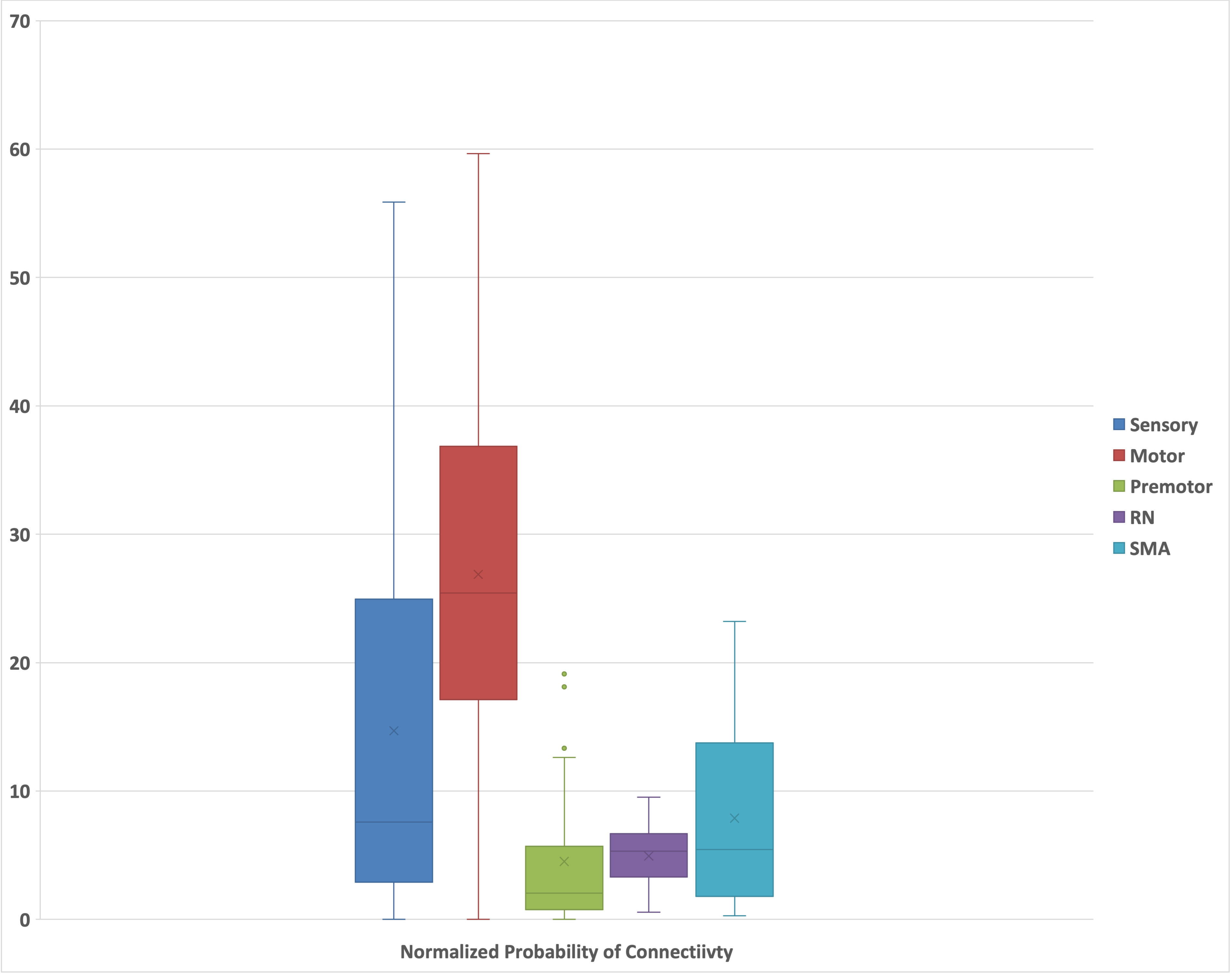Category: Neuroimaging (Non-PD)
Objective: We examine the relationship between adverse effects of MRgFUS thalamotomy in essential tremor (ET) patients and the structural connectivity of the ventral intermediate nucleus (VIM) lesion.
Background: Adverse effects of MRgFUS for ET include paresthesias, gait ataxia or dysmetria, among others [1]. Incorporation of probabilistic tractography may improve safety of MRgFUS by accounting for individual variability in anatomy and structural connectivity [2].
Method: We analyzed MR imaging from 29 MRgFUS thalamotomy ET patients at UCLA. Paresthesias were self-reported by patients, and dysmetria and gait ataxia were documented post-operatively by neurosurgical providers. The VIM lesion was defined and drawn manually. We evaluated the structural connectivity of the lesion with probabilistic tractography and calculated the number of streamlines sent out to the motor (MC) and sensory cortices (SC), premotor cortex (PMC), supplementary motor area (SMA), and red nucleus (RN) [3]. The probability of connectivity to each target was defined and normalized by the distance to each target. Using Welch’s Test for Unequal Variances, we compared the connectivity to each target between patients with and without dysmetria and gait ataxia. We also compared connectivity to the SC between patients with and without paresthesias.
Results: 20.6% (6/29) of patients reported paresthesias. 13% (4/29) patients had dysmetria and gait ataxia. The normalized probability of lesion connectivity to each target was calculated [figure1]. There were no differences in the normalized probability of lesion connectivity to the SC between those with and without paresthesias (17.44±15.95 vs. 13.98±15.35, p=0.65). The normalized probability of lesion connectivity to the PMC was lower in those with gait ataxia than those without (1.40±1.06 vs. 5.00±5.75, p < 0.01).
Conclusion: We demonstrate that those with post-operative dysmetria and gait ataxia had a lower probability of lesion connectivity to the PMC. One possible interpretation is that the lower connectivity may suggest a predisposition to developing post-operative dysmetria and gait ataxia. VIM lesion and PMC connectivity could be further explored to better inform patient counseling of the procedure’s risks or mitigate post-operative dysmetria and gait ataxia in MRgFUS patients.
References: 1. Elias WJ, Lipsman N, Ondo WG, et al. A Randomized Trial of Focused Ultrasound Thalamotomy for Essential Tremor. N Engl J Med. 2016;375(8):730-739. doi:10.1056/NEJMOA1600159
2. Tsolaki E, Downes A, Speier W, Elias WJ, Pouratian N. The potential value of probabilistic tractography-based for MR-guided focused ultrasound thalamotomy for essential tremor. NeuroImage Clin. 2017;17:1019-1027. doi:10.1016/J.NICL.2017.12.018
3. Klein JC, Barbe MT, Seifried C, et al. The tremor network targeted by successful VIM deep brain stimulation in humans. Neurology. 2012;78(11):787-795. doi:10.1212/WNL.0B013E318249F702
To cite this abstract in AMA style:
E. Tsolaki, K. Fu, Z. Rifi, M. Chodakiewitz, W. Wei, N. Pouratian, A. Bari. Examining the association between adverse effects of magnetic resonance-guided focused ultrasound (MRgFUS) thalamotomy for essential tremor and structural connectivity using probabilistic tractography targets [abstract]. Mov Disord. 2023; 38 (suppl 1). https://www.mdsabstracts.org/abstract/examining-the-association-between-adverse-effects-of-magnetic-resonance-guided-focused-ultrasound-mrgfus-thalamotomy-for-essential-tremor-and-structural-connectivity-using-probabilistic-tractography/. Accessed December 19, 2025.« Back to 2023 International Congress
MDS Abstracts - https://www.mdsabstracts.org/abstract/examining-the-association-between-adverse-effects-of-magnetic-resonance-guided-focused-ultrasound-mrgfus-thalamotomy-for-essential-tremor-and-structural-connectivity-using-probabilistic-tractography/

